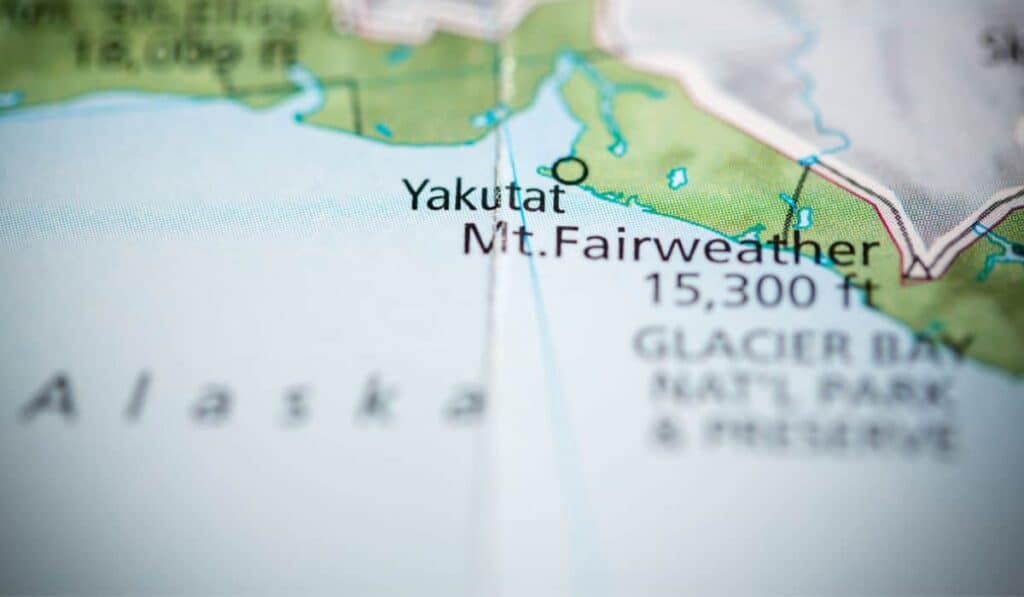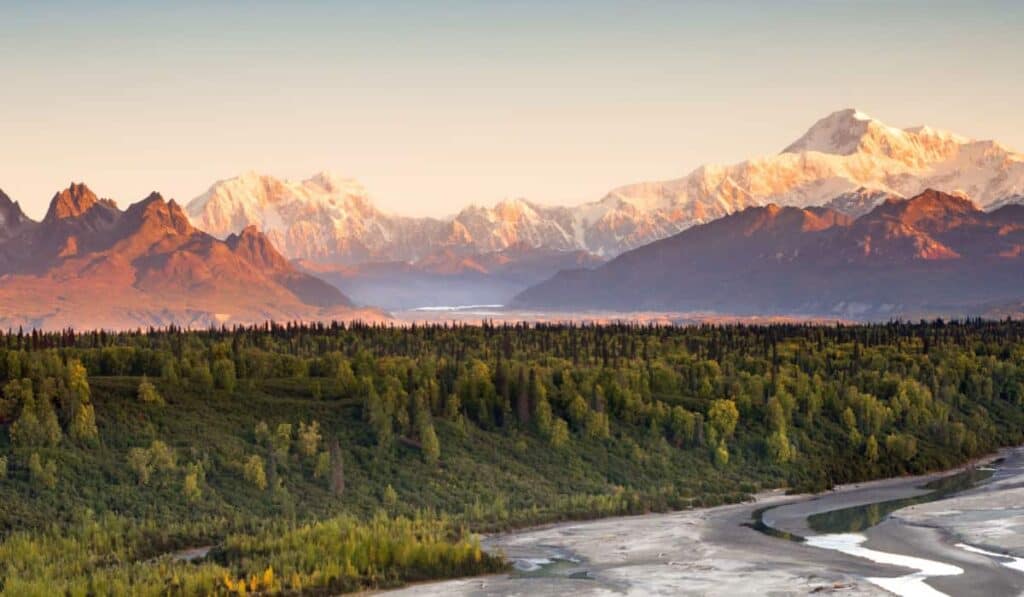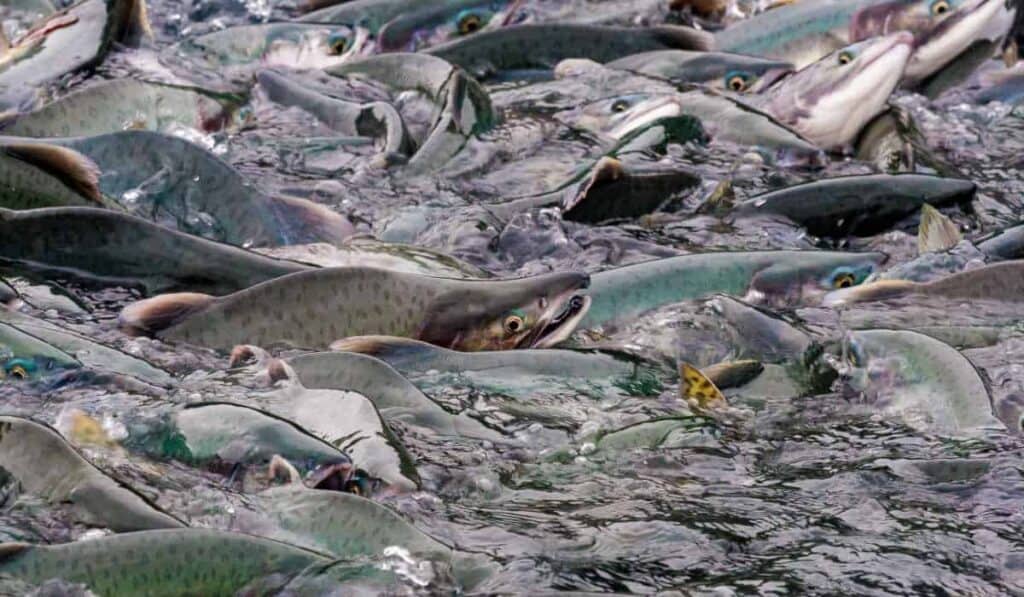I’m sure that just about everyone with a free soul has sat at their desk during a soul-crushing day and wished they could just run away.
I know that when I looked out at the steel and concrete I wished that I could run away to Alaska. It didn’t help that I spent my youth reading gold-rush books and figured that Alaska was the real land of opportunity.
With the advent of shows like Discovery Channel’s “The Alaskan Bush People” homesteading in Alaska has become a much more mainstream topic.
However, it might just be too little too late. For many years you could actually head up to Alaska and receive a free land grant to start homesteading.
But what about today? Can you still homestead in Alaska now?
How Homesteading In Alaska Works (Or “Worked”)

Homesteading involves owning a tract of land, usually without any close neighbors, where the owners are completely self-sufficient. All the household food is grown, trapped, or hunted on the land and outside resources are extremely
The common term “living off the grid” applies to homesteaders, as they (and their families, if applicable) typically remain on their own land most of the time and don’t leave outside of emergencies.
It’s been pretty common throughout human history. In the United States, The Homestead Act of 1862 was signed into law by President Abraham Lincoln and involved the government giving up to 160 acres of land to private citizens.
The only requirements to claim land were that the owners had to physically live on the land, improve it through farming or some other method, and pay a small registration fee.
By 1934, over 270 million acres had passed from the United States Federal Government into the hands of private citizens – over 10% of the total land in the country.
The Federal Land Policy and Management Act of 1976 repealed the Homestead Act but did grant a ten-year extension to allow claims within the State of Alaska.
So, in short, homesteading in Alaska does not exist in the same capacity that it once did. The last federal homesteading program ended on October 21, 1986, and Alaska currently has no such program.
So, Is There Still Free Land In Alaska?
Not anymore. There were some towns in the interior, like Anderson, that used to give away land to potential homesteaders, even as recently as a few years ago.
Currently, the state of Alaska does not offer free land to anyone, residents or non-residents. The closest available program is an over-the-counter sale where non-residents have the chance to buy land at wholesale prices if no resident is interested in putting in a bid for the land.
Even though free land is no longer available in the state, the homesteading lifestyle is still an option if you can afford it.
Wait, afford it? Isn’t homesteading supposed to be an option for people without any money? Well, it was when it was an economic necessity. Now, however, I’m afraid that homesteading is mainly for retirees and hipsters who have the financial ability to escape the rat race and live on their own terms.
The True Costs Of Homesteading In Alaska
Let’s estimate how much it would cost to operate a successful homestead in Alaska. I’ll preface this by saying these numbers are all rough figures and subject to change at any time.
I’ll do my best to keep this updated but, if you’re looking to homestead in Alaska, you’ll probably need to do some more in-depth personal research that this anyway.
The first thing you’d need to do is acquire some land since we’ve established the government is no longer issuing tracts of land for free anymore.
The price of a few acres is going to vary drastically based on what part of the state you’re in and the size of your parcel.
The more remote your land is, the more difficult it would be to get electricity and indoor plumbing. However, if a truly off-grid experience is what you’re after there are some very affordable options, albeit without easy access.
The lowest price I was able to find for privately owned land was $22,000 for five acres about 100 miles outside of Anchorage. You may be able to find something cheaper, but this is what I was able to find in my search.
Even though the government doesn’t give away free land, they do sell it. I probably should have mentioned that earlier as it is often a much cheaper route than buying privately held land.
Alaska’s Department of Natural Resources sells parcels of land in two main different ways: auctions and over-the-counter (OTC).
Land that doesn’t sell at auction within a certain amount of time is available as an OTC purchase. Auctions are only for Alaska residents, but non-residents may purchase OTC land from the department.
OTC land will naturally be cheaper than private land. I found a 6.14-acre parcel in the north, near Mucha Lake for only $14,100.
This particular tract of land, however, like many, has no road access. That means you’d need some sort of ATV (or a plane…) to access your property. This makes getting supplies and building a home a difficult proposition. If you’ve been on the market for homesteading properties you’ll probably find many “unfinished” homes and homesteads in rural Alaska.

This happens often when the builder underestimated the amount of work it would take or simply ran out of money.
If possible you could bring a trailer or RV onto the land and start homesteading in the meantime before incurring the exorbitant costs of building a home – especially in the current market.
Another route many homesteaders take is to build a barndominium. In other words, they convert a bard or shed kit into a livable space.
Home Depot has kits for a shed large enough to sleep one or a house small enough for one, starting at around $12,000 for the house or $2,500 for the shed.
Plant seeds, a hunting rifle, and a fishing pole (plus ammo and bait, respectively) can be acquired very easily in Anchorage, Fairbanks, Juneau, or any other city.
There are also a bunch of incidental expenses (like transportation to and from your plot, the cost of the food you’ll have to bring up to eat while you wait for your crops to bear fruit, etc) that I’m not counting here as well.
In other words, you’ll need quite a bit of money to get set up. Every time I watch a documentary about someone homesteading in Alaska it starts with “…they left their six-figure accounting job to pursue this simple life…” or “…they sold their successful coffee shop to live a subsistence lifestyle”.
Never once has it been, “he left his minimum wage job for a happy life of subsistence farming 160 acres in the Alaskan wilderness. This is why I’m still sitting at my desk typing this instead of milking a goat.
Which States Give Away Free Land For Homesteading?
Homesteading still exists in various parts of the country even now.
North Dakota is a very popular destination for homesteading as the state offers tax breaks and exemptions to homesteaders, as well as financial assistance to prevent homesteaders with economic difficulties from being forced to sell.
A Google search will reveal many locales across the United States, at the city, county, or state level, that offer free land to potential homesteaders.
Homesteading in Present-Day Alaska Is Still Possible

Homesteading, in the sense of living in a secluded place and living off the land, is completely possible.
I worked with a lady a few years ago whose parents moved out of Juneau to start a homestead near Petersburg. Last I heard, they were doing pretty well. But it’s a spartan lifestyle.
Alaska Native tribes like the Tlingit, Athabascan, Yupik, and many others have lived off the land for thousands of years.
Between fishing, hunting, gathering berries, and planting fruits and vegetables, it is very possible to get enough food to live off of and have a healthy diet.
Last Word
All of this comes down to this: the core concept of “homesteading” (living off the land and outside of society) can still be used today.
However, unlike 100 years ago, the government is no longer issuing land up here and it could cost more than most people’s yearly wage just to get started.
That being said, if you save up the money to do it (or the grit to boot-strap it), it can be very rewarding! Just don’t expect free land!







